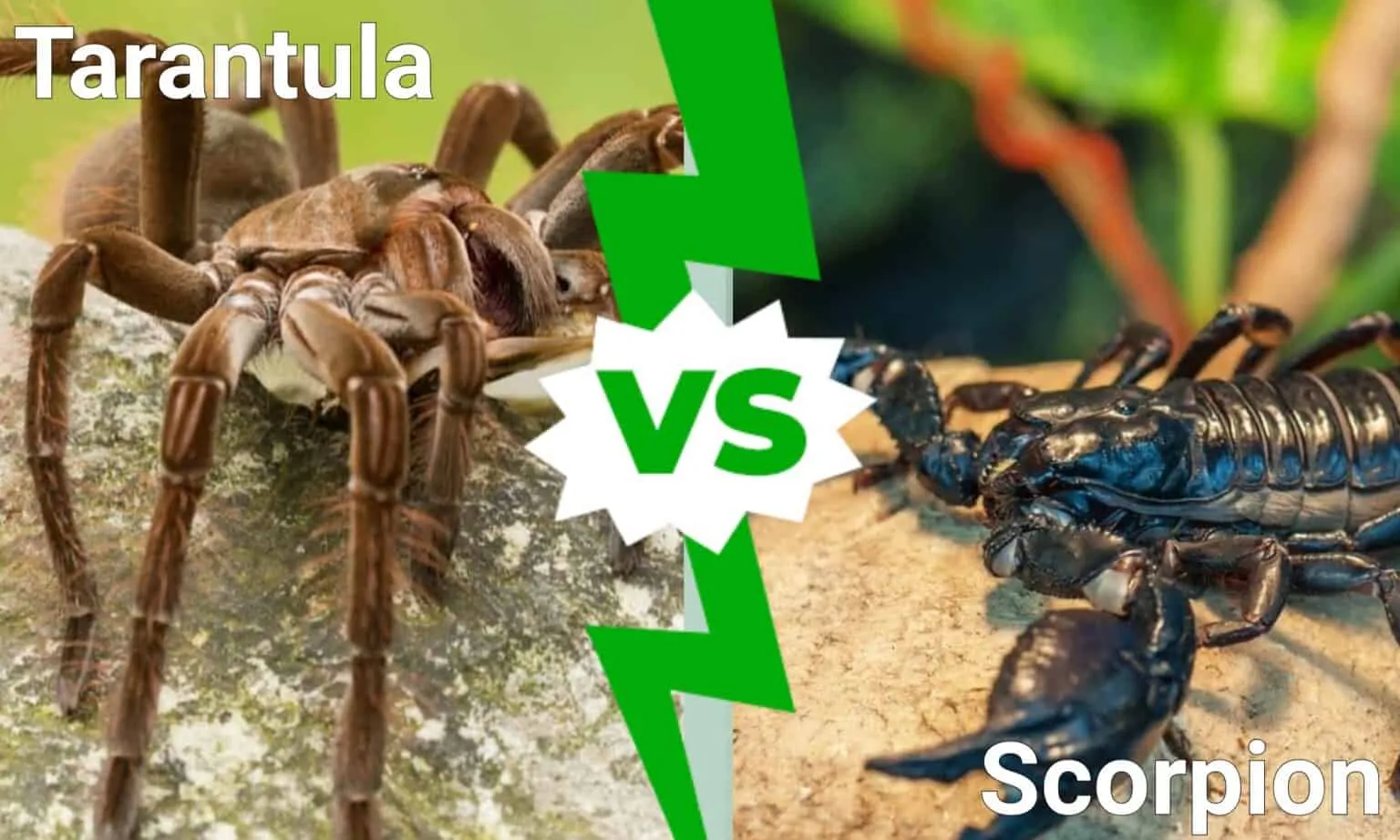Scorpion vs Tarantula An Epic Clash
The natural world is filled with incredible battles, and few are as captivating as the potential showdown between a scorpion and a tarantula. These arachnids, both formidable predators in their own right, often find themselves sharing similar habitats, setting the stage for a clash of titans. This article delves into the fascinating world of scorpions and tarantulas, comparing their physical attributes, habitats, hunting strategies, and defensive mechanisms to provide a comprehensive understanding of their lives. From the arid deserts to the lush rainforests, these creatures have adapted to survive in a variety of environments. The following facts will give you insights into their unique characteristics and the circumstances that would determine the victor in a potential encounter.
Appearance and Physical Attributes
Both scorpions and tarantulas are easily recognized by their distinct appearances, but they have key differences. Understanding their physical attributes provides insights into their survival strategies. Scorpions, with their segmented bodies, possess a pair of pedipalps that are often modified into large claws, used for grasping prey, and a prominent tail ending in a venomous stinger. Their bodies are typically flattened, allowing them to navigate tight spaces, with exoskeletons providing robust protection. Tarantulas, on the other hand, have furry bodies with eight legs, two chelicerae (fangs) and pedipalps. Their size varies dramatically depending on the species, with some being quite large, while others are smaller. The physical characteristics play a significant role in their ability to hunt, defend, and survive in their respective environments. The unique traits set them apart.
Scorpion Physical Characteristics

Scorpions are easily identified by their segmented bodies, which include a cephalothorax (fused head and thorax), an abdomen (or metasoma), and a telson (the stinger). They have eight legs, two pedipalps that function as pincers, and a curved tail that carries the venomous stinger. Their exoskeleton is made of chitin, providing protection against predators. The size of scorpions varies greatly, ranging from less than an inch to over eight inches in length. The shape of the pedipalps and the width of the metasoma can be used to identify specific species. Coloration also differs among species, with some being cryptic shades of brown, black, or tan, while others exhibit vibrant colors. The scorpion’s ability to bend its tail over its body to sting is a key defensive and offensive mechanism.
Tarantula Physical Characteristics
Tarantulas are characterized by their large size, hairy bodies, and eight legs. They have two chelicerae (fangs) that they use to inject venom into their prey. The pedipalps are located near the mouth and are used for manipulating food and sensing the environment. Their bodies consist of a cephalothorax and an abdomen, covered in dense hairs. Tarantulas have two to four spinnerets located at the rear of their abdomen. These spinnerets produce silk, which they use to build webs, line their burrows, and create egg sacs. Their coloration ranges from brown and black to more vibrant hues, often providing camouflage or serving as a warning signal. The size of tarantulas can vary dramatically, with some species having leg spans of over 10 inches.
Habitat and Geographic Distribution
Scorpions and tarantulas have adapted to a variety of habitats across the globe, with their distributions often overlapping in certain regions. The geographical location influences the physical and behavioral traits of each species, shaping their interactions within specific ecosystems. Their ability to survive in diverse environments, from deserts to rainforests, showcases their adaptability and the significance of habitat in their lives. Both scorpions and tarantulas are primarily terrestrial creatures, though some species have adapted to climb trees or burrow underground.
Scorpion Habitats

Scorpions are found on every continent except Antarctica, inhabiting deserts, grasslands, forests, and caves. Many species prefer warm, dry climates, while others thrive in humid environments. They often hide under rocks, logs, or in burrows during the day to avoid the heat and predators. Some species have adapted to live in specific microhabitats, such as rocky crevices or loose soil. The availability of shelter and prey is essential for their survival. Scorpions play an important role in their ecosystems, controlling populations of insects and other small invertebrates. The distribution of scorpion species is greatly influenced by factors such as climate, food availability, and the presence of other predators.
Tarantula Habitats
Tarantulas are primarily found in tropical and subtropical regions around the world, including North and South America, Africa, Asia, and Australia. They inhabit a wide range of environments, including rainforests, grasslands, and deserts. Some species are terrestrial, living in burrows or beneath rocks and logs, while others are arboreal, residing in trees. Their habitat choice is influenced by factors like prey availability, temperature, and humidity. The presence of suitable shelter is crucial for tarantula survival. Their ability to camouflage and adapt to different environments makes them successful predators in their respective ecosystems. The environmental factors play a critical role in their life cycles and behaviors.
Hunting and Feeding Strategies
Scorpions and tarantulas are both skilled predators, employing distinct hunting strategies to capture their prey. Their hunting behaviors are finely tuned to the environment, including sensory perceptions and anatomical adaptations. Understanding these hunting tactics provides insight into their predatory success and ecological roles. The methods used by both scorpions and tarantulas provide clear examples of how these animals have evolved to become top predators in their ecosystems. Both of these arachnids feed primarily on insects and other invertebrates, although some larger species may also consume small vertebrates.
Scorpion Hunting Techniques

Scorpions are typically ambush predators, lying in wait for unsuspecting prey to come within striking distance. They use their pedipalps (pincers) to grasp and immobilize their victims. The venom injected through the stinger paralyzes or kills the prey, allowing the scorpion to consume it. They are nocturnal hunters, using their sensory hairs and the detection of vibrations to locate prey in the darkness. Scorpions can also detect chemical cues left by potential food sources. They often consume their prey whole or tear it apart using their chelicerae (mouthparts). The efficiency of their hunting strategies is one of the keys to their survival. The effectiveness of their hunting is enhanced by their ability to detect vibrations through the ground.
Tarantula Hunting Techniques
Tarantulas are also ambush predators, often waiting in burrows or concealed locations for prey to pass by. They detect vibrations in the ground or web to identify the presence of potential prey. When a suitable target is detected, they quickly pounce, using their fangs to inject venom that paralyzes the prey. Their chelicerae are strong and used for crushing and tearing their food. Some tarantulas actively pursue prey over short distances. They use silk to create trip lines around their burrows. They tend to consume the soft tissues of their prey. They are well-adapted to different environments. The hunting success of these spiders is closely tied to their environment.
Venom and Defensive Mechanisms
Both scorpions and tarantulas possess venom and other defense mechanisms to protect themselves against predators. Understanding how these creatures defend themselves is essential. These defensive strategies play crucial roles in their survival. The primary purposes of venom are to subdue prey and defend against threats, while other defensive tactics offer protection from predators. The effectiveness of each mechanism affects their survival rates.
Scorpion Venom and Defense

Scorpions possess venom that is delivered through their stinger. The venom contains a mixture of neurotoxins that can paralyze or kill prey. The potency of scorpion venom varies significantly among species, with some being more dangerous to humans than others. They also use their pedipalps (claws) to grasp and pinch potential threats. The shape and size of the claws and the level of venom can impact its effect. Defensive behaviors, like arching their bodies and raising their tails, are commonly used to intimidate predators. The scorpion’s defensive capabilities help protect it against a range of predators.
Tarantula Venom and Defense
Tarantulas inject venom through their fangs to subdue their prey and defend against predators. The venom is generally not lethal to humans, but can cause pain, swelling, and other local symptoms. Many tarantula species possess urticating hairs on their abdomens, which they flick towards threats. These hairs cause irritation and can deter predators. Some species also employ defensive postures, such as rearing up and exposing their fangs. Tarantulas are known for using silk to create defensive structures. Their defense mechanisms are key to their survival.
Interesting Facts and Behaviors
Beyond their basic biology, scorpions and tarantulas have fascinating behaviors. The interesting facts surrounding these creatures provide a window into their complex lives. These animals exhibit behaviors that are crucial for their survival. Their adaptations to various conditions have allowed them to thrive in their specific environments. Observing these interesting aspects of their behaviors demonstrates how these creatures interact with their environment.
Scorpion Interesting Behaviors

Scorpions exhibit interesting behaviors, including mating rituals that involve elaborate dances and courtship displays. Females often carry their young on their backs until they are able to fend for themselves. Some species exhibit parental care, guarding their offspring from predators. They also have a remarkable ability to withstand extreme conditions, such as prolonged periods without food or water. Their nocturnal habits and ambush hunting strategies have evolved to maximize their survival in challenging environments. They can also glow under ultraviolet light due to fluorescent compounds in their exoskeleton.
Tarantula Interesting Behaviors
Tarantulas are known for their diverse behaviors. They engage in complex mating rituals. Female tarantulas often eat their male partners after mating. They shed their exoskeletons as they grow, a process known as molting. They also create silk webs for shelter and to aid in hunting. Many species are relatively docile. The life cycle of a tarantula involves multiple molts. These interesting behaviors highlight their adaptability.
